Claire Hennessy's Blog, page 11
May 15, 2017
Bits ‘n’ pieces ‘n’ new book!
Firstly, some things I’ve loved recently:
Tara Flynn’s Not A Funny Word at the Peacock, which made me have All The Feels
Crazy Ex-Girlfriend, which I’ve just started (after months of being told You Will Adore This It Is So Your Thing), and, y’know, I adore it, it is so my thing
Grace and Frankie, which is the best sitcom ever about a gay couple (oh yes and their ex-husbands) – seriously, how are Jane Fonda and Lily Tomlin still that fabulous?
So, some things I’m doing soon:
I’ll be in Wexford Library on Thursday May 18th, 7pm, on a panel with the mighty Sinéad Gleeson & fierce Sarah Maria Griffin about ‘The Feminist Voice in Irish Fiction’
I’ll be yammering about Queer Representations in Irish Writing (as part of International Literature Festival Dublin) on Saturday May 20th, 2pm
Also as part of ILF Dublin, I’ll be taking part in the Headstuff Lectures from 8pm on Wednesday May 24th
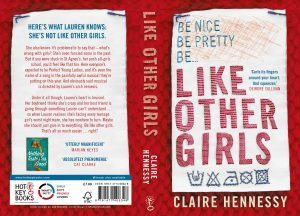
I appear to have a new book out.
It’s launching in Eason’s O’Connell St, 6pm Thursday May 25th – all welcome!
If you’d like to be in with a chance to win a signed copy, I am running giveaways on: facebook | twitter |
instagram.
Here and here are some thoughtful reviews of the book.
Finally, some bits ‘n’ pieces about books from The Irish Times:
May YA reviews, including latest from Patrick Ness, David Owen, Virginia Macgregor, Karen Gregory & Cat Clarke
the new Anne of Green Gables Netflix series (but more importantly the new book covers)
Chris Judge & Andrew Judge talk superheroes and more
picturebook maker Yasmeen Ismail on drawing emotions, creativity and the school system
May 11, 2017
Book Review: The Cows
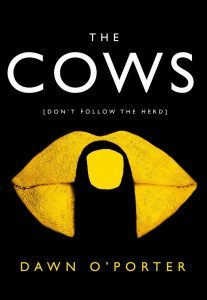
Dawn O’Porter’s first adult novel (she has written non-fiction as well as YA fiction previously) sets out its stall from the opening page, inviting women not to be like cows, not to ‘follow the herd’ – especially about motherhood. Make your own choices. Live your own life. All very inspirational, but what does it mean in practice?
After the opening, though, we see that choosing not to follow the herd is much harder than it seems. The narrative shifts between three women: single mother Tara, lifestyle blogger Cam, and personal assistant Stella – brought together after a single unguarded moment makes Tara the talk of the town (and the internet).
Tara thinks she’s alone when she masturbates on a late-night Tube train home, after the best date she’s had in years. She doesn’t expect to become ‘Wank Woman’, named and shamed for all the world to see – an event that shakes her relationships and ensures she loses her job. In an era where everyone with a smartphone has an opinion and feels compelled to share it, Cam is the sole voice of reason, someone who’s horrified at the violation of Tara’s privacy and blogs about it. A friendship begins between the two women, while Stella – who has her own designs on Tara’s date – schemes to ensure she gets what she wants out of all this.
Each of the characters is nuanced and O’Porter avoids a definitive answer to any of the Big Questions; Stella begins as a huge Cam fan and grows to loathe her take on childlessness and women’s choices. This is a page-turner with a feminist slant and a couple of sharp twists – an easy but not simplistic read.
May 4, 2017
Book Review: A Line Made By Walking
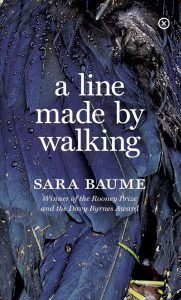
Sara Baume’s second novel has been much-feted for its brave lack of plot by literary types (as though an inability to tell a story is somehow a virtue) so I was surprised – and pleased – to find that although sections of the narrative veer towards nature-writing, this is, yes (gasp!) – an actual novel. With a plot and everything.
25-year-old Frankie is an art graduate already broken by the failure of the world to live up to what she imagined, and by her own failure to live up to her expectations. What is she, now that she is only tangentially – she has just finished an internship at an art gallery – linked to the world of art? What is she if she is not making things?
Retreating from the world, she takes over her dead grandmother’s bungalow, and in the middle of nowhere she sets herself a project: to photograph the dead animals around her. To mark them. To say something, perhaps, about the impermanence of things. Or the permanence of it, the ongoing loss and sadness that is so much a part of life. There is nothing cutesy or forced about this project, represented in the text by black-and-white photographs (the author’s own) at the beginning of every chapter.
Frankie is sad. She is lost. And although she resists doctors’ suggestions that this depression is chemical rather than social, or might be alleviated by chemicals at any rate, this feels very much like a depiction of mental illness. It reminded me of Susanna Kaysen’s Girl, Interrupted, which raises similar questions about whether ‘madness’ is simply not fitting into what the world expects (particularly of women) or a genuine illness.
There are no easy answers in this novel, which ends on both a melancholy and hopeful note. It feels like a stupidly obvious thing to note about Baume’s writing, but it’s utterly gorgeous. Her attention to detail – whether about the physical world or the inner thoughts of her protagonist – is superb. This is a sad, beautiful book.
April 27, 2017
Book Review: My Not So Perfect Life
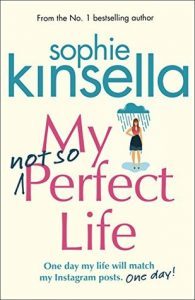
Sophie Kinsella specialises in taking current trends and perennial insecurities and combining them into a somewhat-implausible but appealingly-empowering yarn – here we see what happens when a ‘has it all’ girl loses it and has to keep pretending. Except Katie never really had it all to begin with; her carefully-curated social media profile makes her life seem far more glamorous than it actually is, and even her friends and family don’t know the truth about her tiny shared apartment or her low-level job.
Her nemesis at work, Demeter, seems to be the living embodiment of everything Katie wants to be. Pity that Demeter can’t stand her (when she notices her existence at all, of course). And when Demeter fires her – well, that’s the last straw. Hiding out at home, in decidedly unglamorous Somerset, Katie becomes involved in helping her parents set up a ‘glamping’ resort – all the while hoping no one from London and what she still thinks of as her ‘real’ life turns up.
So naturally, Demeter and her family are about to arrive for a visit – and Katie’s determined to get her revenge. Things get more complicated, though, and she realises Demeter’s not nearly as ‘together’ as she seems – and that they might be able to help each other out.
The workplace politics are, as usual, beautifully portrayed, and the satirising of faux-natural/organic/wholesome culture is hilarious. A most pleasing read indeed.
April 20, 2017
Book Review: The American Girl
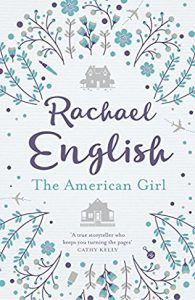 Broadcaster Rachael English explores an all-too-familiar topic in her third novel: the Magdalen laundries of twentieth-century Ireland and the long shadow they cast over the women incarcerated in them. But this story goes far beyond the usual ‘wasn’t it terrible’ approach – after all, we know it was.
Broadcaster Rachael English explores an all-too-familiar topic in her third novel: the Magdalen laundries of twentieth-century Ireland and the long shadow they cast over the women incarcerated in them. But this story goes far beyond the usual ‘wasn’t it terrible’ approach – after all, we know it was.
We first meet Rose as a seventeen-year-old Irish-American living in Boston, the youngest of six children in a family struggling desperately to be respectable. Her boyfriend, Joe Brennan, may be the love of her life but he is absolutely not someone she can ever marry, it has been decided – not by her, but by her controlling parents. When Rose gets pregnant, she’s shipped off to a home in Ireland where her aunt is a nun, and very quickly we see the expected outcome: the child is taken away from her.
Rose, unlike some of the other girls there, doesn’t need to stay to pay back her keep; her father has covered those charges and arrives to take her back home. Cut to Dublin forty-five years later, where Martha – fresh from the news of her ex-husband’s new partner’s pregnancy – is under pressure from both her best friend and her teenage daughter, Evanne, to track down her birth mother before it’s too late.
The slow development of the relationship between Martha and Rose, and how it impacts on the rest of their lives, is played out in a realistic manner. On the one hand, it is a joyous reunion, and on the other, it stirs up secrets from the past that are difficult to deal with. Both Martha’s birth mother and adoptive mother are complicit in certain deceptions, and Martha too is conscious of hiding the truth of an abortion from her own former partner.
This is a compelling read with engaging characters – particularly the teenage Evanne, who both loves her family and is frustrated by it, and who comes off as a lot more rounded than many teen characters in fiction intended for adults. The tendency to moralise in a book like this is undoubtedly tempting, but the narrative thankfully avoids this and lets us arrive at our own conclusions and assessments of each character.
April 19, 2017
Book reviews (& features, interviews etc) elsewhere
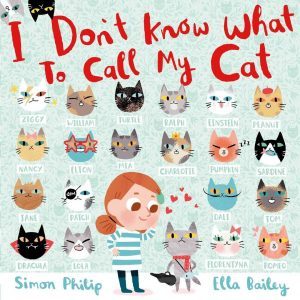
Playing catch-up!
February kidlit & YA reviews
March kidlit & YA reviews
April YA reviews
what smart humans have to say about Philip Pullman and his influence on children’s/YA fiction
how the Irish World Book Day title is chosen
Ally Carter on writing about ’embassy kids’
Jacqueline Wilson on film adaptations and classic literature
how much money children’s & YA writers really make (or don’t)
the best female leads in children’s fiction
April 13, 2017
Book Review: The Girl Before
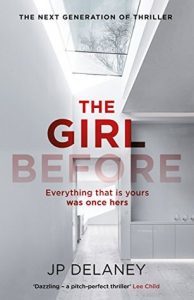
Imagine a house with very specific rules for living there, and personal, thought-provoking questions asked before you were even allowed rent it, beginning with: Please make a list of every possession you consider essential to your life.
The technology means that the house knows you. Once in the house, everything is connected via wifi – your mobile phone controls everything. In theory. But there may well be moments when you’re not in control at all . . .
The potential for this troubled-young-women-who-get-sucked-into-relationships-with-men-they-cannot-trust story to be strengthened and lifted up by this focus on technology, by this half-sci-fi and half-haunted-house feeling, peters out, though.
Here’s what we know: there are two women, Emma and Jane, who have lived in that house and who tell their stories – years apart – in alternating sections. Their lives converge in other ways as they meet the mysterious architect who designed the house, and who seems to have a ‘type’ – the same type as his dead wife. Who he may have murdered.
Mr Architect is set up as so utterly creepy that the big ‘twist’ falls flat, where the more obvious and predictable plot would have been infinitely more satisfying. The scenario here could have been amazing, but it descends into chaos. Best to stay The Girl Before Reading This.
April 6, 2017
Book Review: Behind Her Eyes
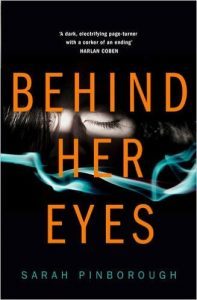
Louise is a single mother, a secretary whose new boss, David, turns out to be the guy she met – and kissed – at the bar the weekend before. The very married guy. Adele is his wife – who befriends Louise, even as the affair between the two continues. There’s something not quite right about this from the start, but the nature of that wrongness remains up in the air.
Much has been made of the great twist in this novel – there are actually two, and it’s up for debate whether that second one is needed quite so soon after the first, and/or whether the proximity of the two to each another takes away some of their individual impact. The second is, I think, much more ‘what the hell?!’ and the promised ending ‘you’ll never guess’, but there are slivers of hints in certain chapters (if you are reading with a sense of determination that you will indeed guess the twist). The first is a shocking culmination to something hinted at from quite early on, and made fairly explicit by about a quarter of the way through – yes, there is something supernatural going on here, and even the nature of that something is quite clearly established, even if we don’t yet understand its limits or capacities yet.
But quite aside from that supernatural element, it is quite every-day and relatable, with a tone closer to ‘women’s fiction’ than what one might typically expect from a psychological thriller.
I enjoyed reading this very much, though I’m not sure I’d be inclined to go back to it again for a re-read just to see how it all falls into place – the thrill of it was turning the pages frantically to see what would happen next.
April 2, 2017
Book Review: The Finishing School
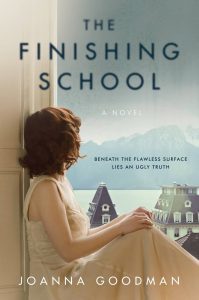
Kersti has almost forgotten the events that led to her early departure from an elite Swiss boarding school twenty years ago – until two pieces of post call the past back. One is an invitation to the school’s centenary – as a published writer, Kersti’s been invited to speak at the event. The other is a letter from a now-dead classmate concerning the night their mutual friend Cressida fell from her balcony – convinced that it wasn’t an accident.
What follows is a fairly typical back-and-forth between the past and present. Kersti, of Estonian heritage but raised in Toronto, is the outsider at the prestigious school, the scholarship kid among the very wealthy. The glamour and privilege she encounters as a teenager isn’t quite as vividly realised as it could be, but her friendship with the charismatic and beautiful Cressida – there’s always one girl like that, isn’t there? – is well drawn and believable.
These intense teen years – as Kersti later reflects, her memories of the area are so vivid because so many of her formative experiences happened here – are more engaging than her present-day discussions and deliberations, offering up a version of Swiss-Alps-boarding-school-life that’s a great deal more sinister than anything the Chalet School had to offer.
March 30, 2017
Book Review: He Said/She Said
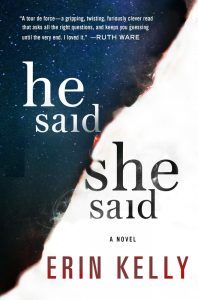
Laura and Kit have changed their names, and live in fear of the past catching up with them. Their obsession – Kit’s, really – with eclipses, however, means that it’s easy to track them down at certain times. In 2015, with Laura at home pregnant, Kit is venturing up close towards the Arctic Circle – and both of them are terrified that Beth will return.
Who is Beth, you might ask? A former friend – one, it’s slowly revealed, they met at a festival sixteen years previously, and who seems to be unstable and a bit of a stalker. The circumstances under which they met were intense – Laura witnessed her being raped by a privileged wealthy young man, and lied for her in court, insisting she heard a verbal ‘no’ as opposed to just watching the sheer wordless terror of a young woman being assaulted. This is something she still feels guilty about, even as the novel makes it patently clear that it’s almost impossible to convict someone of rape.
There is a lot here that feels like it needs more work – what is Laura’s own relationship with sexual assault, for example? The intensity of her response implies that all women have immediate empathy with this particular trauma, yet this is never explored. Rape is presented both as the ultimate traumatic experience and as something that might just accidentally happen – touching, of course, on the ‘he said/she said’ theme of the book, but still quite uncomfortable.
This is a novel that tries to do clever things with symbolism (eclipses! Shadows! Black and white and nuance!) but ultimately falls a little flat.



